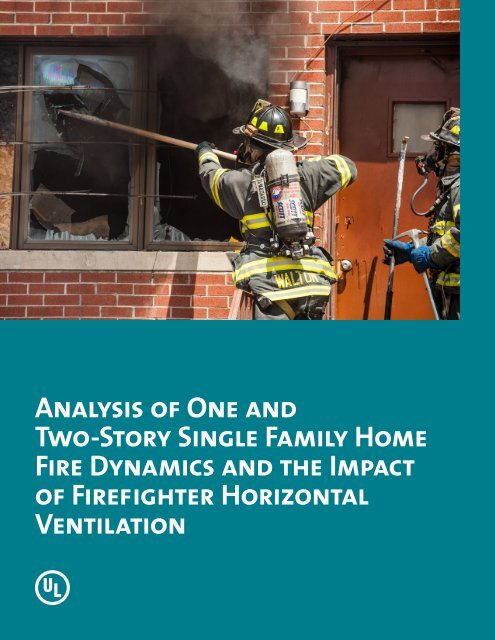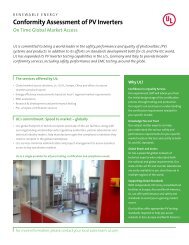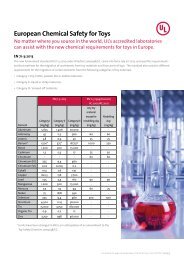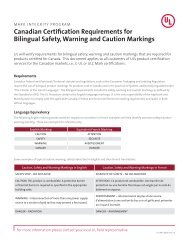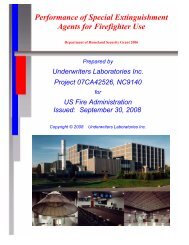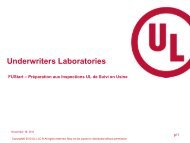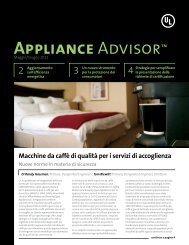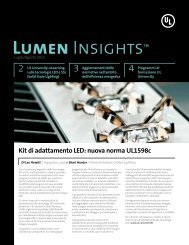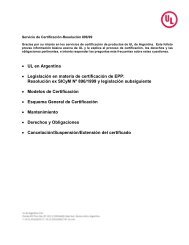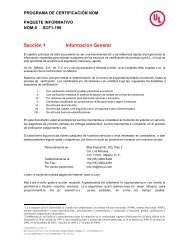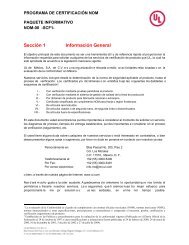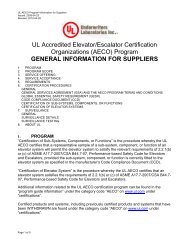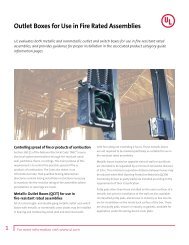Analysis of One and Two-Story Single Family Home Fire ... - UL.com
Analysis of One and Two-Story Single Family Home Fire ... - UL.com
Analysis of One and Two-Story Single Family Home Fire ... - UL.com
Create successful ePaper yourself
Turn your PDF publications into a flip-book with our unique Google optimized e-Paper software.
<strong>Analysis</strong> <strong>of</strong> <strong>One</strong> <strong>and</strong><br />
<strong>Two</strong>-<strong>Story</strong> <strong>Single</strong> <strong>Family</strong> <strong>Home</strong><br />
<strong>Fire</strong> Dynamics <strong>and</strong> the Impact<br />
<strong>of</strong> <strong>Fire</strong>fighter Horizontal<br />
Ventilation
This paper describes experimental investigations on fire service ventilation practices<br />
in modern house geometries. <strong>Two</strong> houses were constructed inside a large fire facility.<br />
The first <strong>of</strong> two houses constructed was a one-story, 111.5 m2, 3 bedroom, 1 bathroom<br />
house with 8 total rooms. The second house was a two-story 297.3 m2, 4 bedroom,<br />
2.5 bathroom house with 12 total rooms. The second house featured a modern open<br />
floor plan, two-story great room <strong>and</strong> open foyer. Fifteen experiments were conducted<br />
varying the ventilation locations <strong>and</strong> the number <strong>of</strong> ventilation openings. Ventilation<br />
scenarios included ventilating the front door only, opening the front door <strong>and</strong> a window<br />
near <strong>and</strong> remote from the seat <strong>of</strong> the fire, opening a window only <strong>and</strong> ventilating a<br />
higher opening in the two-story house. <strong>One</strong> scenario in each house was conducted in<br />
triplicate to examine repeatability. The results <strong>of</strong> these experiments examine potential<br />
occupant tenability <strong>and</strong> provide knowledge for the fire service for them to examine<br />
their horizontal ventilation st<strong>and</strong>ard operating procedures <strong>and</strong> training content. The<br />
fire dynamics resulting from ventilation practices such as ventilation near or remote<br />
from the seat <strong>of</strong> the fire <strong>and</strong> high versus low in relation to the fire are examined. Several<br />
other tactical considerations were developed utilizing the data from these experiments<br />
to provide specific examples <strong>of</strong> changes that can be adopted based on a departments<br />
current strategies <strong>and</strong> tactics. Such tactical considerations <strong>and</strong> a systems approach to<br />
fire service tactics should be investigated further.<br />
page 2<br />
<strong>Analysis</strong> <strong>of</strong> <strong>One</strong> <strong>and</strong> <strong>Two</strong>-<strong>Story</strong> <strong>Single</strong> <strong>Family</strong> <strong>Home</strong> <strong>Fire</strong> Dynamics<br />
<strong>Analysis</strong> <strong>of</strong> <strong>One</strong> <strong>and</strong> <strong>Two</strong>-<strong>Story</strong> <strong>Single</strong> <strong>Family</strong><br />
<strong>Home</strong> <strong>Fire</strong> Dynamics <strong>and</strong> the Impact <strong>of</strong> <strong>Fire</strong>fighter<br />
Horizontal Ventilation<br />
Stephen Kerber<br />
Introduction<br />
Ventilation is frequently used as a<br />
firefighting tactic to control <strong>and</strong> fight<br />
fires. In firefighting, ventilation refers<br />
to the process <strong>of</strong> creating an opening so<br />
that heat <strong>and</strong> smoke will be released,<br />
permitting the firefighters to locate<br />
<strong>and</strong> attack the fire. If used properly,<br />
ventilation improves visibility <strong>and</strong><br />
reduces the chance <strong>of</strong> flashover or back<br />
draft. However, poorly placed or timed<br />
ventilation may increase the air supply<br />
to the fire, causing it to rapidly grow<br />
<strong>and</strong> spread [1].<br />
When ventilation is increased, either<br />
through tactical action <strong>of</strong> firefighters<br />
or unplanned ventilation resulting<br />
from effects <strong>of</strong> the fire (e.g., failure <strong>of</strong><br />
a window) or human action (e.g., door<br />
opened), heat release will increase,<br />
potentially resulting in flashover<br />
conditions. These changing fire conditions
are sometimes unexpectedly swift,<br />
providing little time for firefighters<br />
to react <strong>and</strong> respond. The changing<br />
dynamics <strong>of</strong> residential fires as a result<br />
<strong>of</strong> the changes in construction materials,<br />
building contents, <strong>and</strong> building size <strong>and</strong><br />
geometry over the past 50 years add<br />
<strong>com</strong>plexity to the influence <strong>of</strong> ventilation<br />
on fire behavior [2].<br />
Traditional fire service training does<br />
not effectively replicate the impact<br />
<strong>of</strong> ventilation. A large number <strong>of</strong> fire<br />
training buildings are made <strong>of</strong> concrete or<br />
st<strong>and</strong>ard shipping containers <strong>and</strong> utilize<br />
small fuel loads to increase the safety<br />
<strong>of</strong> the training exercises. As a result, any<br />
ventilation practices utilized in these<br />
buildings leads to improved conditions.<br />
If instructors do not explain how these<br />
page 3<br />
<strong>Analysis</strong> <strong>of</strong> <strong>One</strong> <strong>and</strong> <strong>Two</strong>-<strong>Story</strong> <strong>Single</strong> <strong>Family</strong> <strong>Home</strong> <strong>Fire</strong> Dynamics<br />
training exercises differ from ventilation<br />
under real world conditions, firefighters<br />
may gain a false sense <strong>of</strong> reality <strong>and</strong><br />
potentially use incorrect tactics during<br />
actual incidents.<br />
The rate for traumatic firefighter deaths<br />
occurring outside structures or from<br />
cardiac arrest has declined while, at the<br />
same time, the rate <strong>of</strong> firefighter deaths<br />
occurring inside structures has continued<br />
to climb over the past 30 years [3]. It is<br />
believed that one significant contributing<br />
factor is the lack <strong>of</strong> underst<strong>and</strong>ing <strong>of</strong><br />
fire behavior in residential structures<br />
resulting from both natural ventilation<br />
<strong>and</strong> the use <strong>of</strong> ventilation as a firefighter<br />
practice. Three recent ventilation related<br />
incidents have resulted in firefighter<br />
fatalities <strong>and</strong> were investigated by the<br />
National Institute for Occupational Safety<br />
<strong>and</strong> Health (NIOSH). In 2010, a fire in<br />
a one-story house claimed the life <strong>of</strong> a<br />
firefighter <strong>and</strong> the investigation report<br />
suggests, ‘‘<strong>Fire</strong> departments should<br />
ensure that fire fighters <strong>and</strong> <strong>of</strong>ficers have<br />
a sound underst<strong>and</strong>ing <strong>of</strong> fire behavior<br />
<strong>and</strong> the ability to recognize indicators <strong>of</strong><br />
fire development <strong>and</strong> the potential for<br />
extreme fire behavior [4].’’ The second<br />
incident occurred in 2000 <strong>and</strong> resulted<br />
in NIOSH suggesting, ‘‘Ventilation timing<br />
is extremely important <strong>and</strong> must be<br />
carefully coordinated between both fire<br />
attack <strong>and</strong> ventilation crews. [5].’’<br />
A third incident in 2008 claimed the life<br />
<strong>of</strong> one firefighter <strong>and</strong> one civilian. The<br />
NIOSH report conclusion states ‘‘This<br />
contributory factor (tactical ventilation)<br />
EXPERIMENT STRUCTURE LOCATION OF IGNITION VENTILATION PARAMETERS<br />
1 1-<strong>Story</strong> Living Room Front door<br />
2 2-<strong>Story</strong> <strong>Family</strong> Room Front door<br />
3 1-<strong>Story</strong> Living Room Front door + LR window<br />
4 2-<strong>Story</strong> <strong>Family</strong> Room Front door + FR1 window<br />
5 1-<strong>Story</strong> Living Room LR window only<br />
6 2-<strong>Story</strong> <strong>Family</strong> Room FR1 window only<br />
7 1-<strong>Story</strong> Living Room Front door + BR2 window<br />
8 2-<strong>Story</strong> <strong>Family</strong> Room Front door + BR3 window<br />
9 1-<strong>Story</strong> Living Room Front door + LR window (Repeat Exp. 3)<br />
10 2-<strong>Story</strong> <strong>Family</strong> Room Front door + FR1 window (Repeat Exp. 4)<br />
11 2-<strong>Story</strong> <strong>Family</strong> Room Front door + FR1 window (Repeat Exp. 4)<br />
12 1-<strong>Story</strong> Living Room Front door + LR window (Repeat Exp. 3)<br />
13 2-<strong>Story</strong> <strong>Family</strong> Room Front door + FR3 Window<br />
14 1-<strong>Story</strong> Living Room Front door + 4 windows (LR, BR1, BR2, BR3)<br />
15 2-<strong>Story</strong> <strong>Family</strong> Room Front door + 4 windows (LR, Den, FR1, FR2)<br />
Table 1: Experimental series
points to the need for training on<br />
the influence <strong>of</strong> tactical operations<br />
(particularly ventilation) on fire behavior<br />
[6].’’ There has been little research<br />
conducted to provide the fire service<br />
with data they need to update their<br />
ventilation tactics especially with<br />
changes to the fire environment over<br />
the last several decades.<br />
Traditionally, the fire service has adapted<br />
their tactics based on knowledge or<br />
experience gained while fighting fires<br />
<strong>and</strong> passing that information on through<br />
the generations. This approach can be<br />
very slow to adapt to changes <strong>and</strong> can<br />
be incorrect because rarely are two fires<br />
identical so the variables encountered<br />
are never well understood. The research<br />
in this study examines these variables to<br />
provide the scientific knowledge currently<br />
lacking in the fire service needed to<br />
supplement their training system.<br />
Full-Scale House Experiments<br />
To examine ventilation practices as well<br />
as the impact <strong>of</strong> changes in modern house<br />
geometries, two houses were constructed<br />
inside a large fire experimental facility.<br />
Fifteen experiments were conducted<br />
varying the ventilation locations <strong>and</strong> the<br />
number <strong>of</strong> ventilation openings (Table 1).<br />
Ventilation scenarios were designed to<br />
examine <strong>com</strong>mon fire service practices<br />
<strong>and</strong> included the following: ventilating<br />
the front door only, opening the front<br />
door <strong>and</strong> a window near <strong>and</strong> remote from<br />
the seat <strong>of</strong> the fire, opening a window<br />
only, <strong>and</strong> ventilating a higher opening in<br />
the two-story house. <strong>One</strong> scenario in each<br />
structure was conducted in triplicate to<br />
examine repeatability. Experiments in<br />
each house were conducted 3 days apart<br />
page 4<br />
<strong>Analysis</strong> <strong>of</strong> <strong>One</strong> <strong>and</strong> <strong>Two</strong>-<strong>Story</strong> <strong>Single</strong> <strong>Family</strong> <strong>Home</strong> <strong>Fire</strong> Dynamics<br />
to allow for ambient conditions inside the<br />
houses between 15 <strong>and</strong> 22°C <strong>and</strong> below<br />
50% relative humidity prior to ignition.<br />
<strong>One</strong>-<strong>Story</strong> Structure<br />
Seven <strong>of</strong> the experiments took place<br />
in the one-story house. The house was<br />
designed to be representative <strong>of</strong> a home<br />
constructed in the mid-twentieth century<br />
with walls <strong>and</strong> doorways separating<br />
all <strong>of</strong> the rooms <strong>and</strong> 2.4 m ceilings. The<br />
one-story house had an area <strong>of</strong> 111.5 m 2 ;<br />
with three bedrooms, one bathroom<br />
<strong>and</strong> eight total rooms (Figure 1). The<br />
home was wood framed, lined with two<br />
layers <strong>of</strong> gypsum board (Base layer 16<br />
mm, Surface layer 13 mm) to protect<br />
the structure <strong>and</strong> allow for multiple<br />
experiments. All <strong>of</strong> the windows were<br />
filled with plugs so that window opening<br />
could be controlled by removing the plugs<br />
at the time specified for each experiment.<br />
<strong>Two</strong>-<strong>Story</strong> Structure<br />
The two-story house had an area <strong>of</strong><br />
297.3 m 2 ; with four bedrooms, 2.5<br />
bathrooms house <strong>and</strong> 12 total rooms<br />
(Figures 2, 3). The house incorporated<br />
modern features such as an open floor<br />
plan, two-story great room, <strong>and</strong> open<br />
foyer. The home was also a wood framed<br />
structure lined with two layers <strong>of</strong> gypsum<br />
board (Base layer 16 mm, Surface layer 13<br />
mm). All <strong>of</strong> the windows were filled with<br />
plugs so that window opening could be<br />
controlled by removing the plugs at the<br />
time specified for each experiment.<br />
Fuel Load<br />
Both houses were furnished with like<br />
furnishings. Figures 4, 5 6 show three<br />
dimensional renderings <strong>of</strong> both houses<br />
with furniture locations. The living<br />
room (LR) in the one-story house, along<br />
with the family room <strong>and</strong> the LR in the<br />
two-story house, were furnished similarly<br />
with two s<strong>of</strong>as, armoire, television, end<br />
table, c<strong>of</strong>fee table, chair, two pictures,<br />
lamp with shade <strong>and</strong> two curtains. The<br />
floor was covered with polyurethane<br />
foam padding <strong>and</strong> polyester carpet. The<br />
fuel loading was approximately 29 kg/m 2 .<br />
In order to characterize the living/family<br />
room fuel load it was placed in a 5.5 m<br />
wide by 4.0 m deep room with a 2.4 m<br />
high ceiling. The room had a 3.7 m wide<br />
by 2.1 m tall opening on the front wall.<br />
The room was placed under an oxygen<br />
consumption calorimeter <strong>and</strong> a peak heat<br />
release rate <strong>of</strong> 11.3 MW was measured.<br />
Bedroom 1 in both houses was furnished<br />
with a queen bed <strong>com</strong>prised <strong>of</strong> a<br />
mattress, box spring, wood frame,<br />
two pillows <strong>and</strong> <strong>com</strong>forter. The room<br />
also contained a dresser, armoire <strong>and</strong><br />
television. The floor was covered with<br />
polyurethane foam padding <strong>and</strong> polyester<br />
carpet. The remainder <strong>of</strong> the bedrooms<br />
(2–4) in both houses was furnished with<br />
the same bed, armoire, television <strong>and</strong><br />
flooring <strong>com</strong>pliment as well as a smaller<br />
dresser, headboard, <strong>and</strong> a framed mirror.<br />
The dining room <strong>of</strong> both houses was<br />
furnished with a solid wood table <strong>and</strong><br />
four upholstered chairs. The kitchens<br />
were furnished with the same table<br />
<strong>and</strong> chairs as the dining room, as well<br />
as a dishwasher, stove, refrigerator <strong>and</strong><br />
oriented str<strong>and</strong> board base cabinets with<br />
cement board counters. The floors <strong>of</strong><br />
both rooms were also cement board to<br />
simulate a tile floor. The two-story house<br />
also had a den on the first floor in which a<br />
stuffed chair was placed as a target fuel.
Figure 1: <strong>One</strong>-<strong>Story</strong> house floor plan<br />
Instrumentation<br />
The measurements taken during the<br />
experiments included gas temperature,<br />
gas velocity, gas concentrations, <strong>and</strong><br />
video recording. Gas temperature was<br />
measured with bare-bead, Chromel–<br />
Alumel (type K) thermocouples, with a<br />
0.5 mm nominal diameter. Thermocouple<br />
arrays locations are shown in Figures 1, 2<br />
<strong>and</strong> 3. The thermocouples were located<br />
in the LR <strong>and</strong> hallway in the one-story<br />
house <strong>and</strong> foyer <strong>and</strong> second floor hallway<br />
page 5<br />
<strong>Analysis</strong> <strong>of</strong> <strong>One</strong> <strong>and</strong> <strong>Two</strong>-<strong>Story</strong> <strong>Single</strong> <strong>Family</strong> <strong>Home</strong> <strong>Fire</strong> Dynamics<br />
Figure 2: <strong>Two</strong>-<strong>Story</strong> house first floor plan Figure 3: <strong>Two</strong>-<strong>Story</strong> house second floor plan<br />
in the two-story house. Each location<br />
had an array <strong>of</strong> thermocouples with<br />
measurement locations <strong>of</strong> 0.03 m, 0.3 m,<br />
0.6 m, 0.9 m, 1.2 m, 1.5 m, 1.8 m <strong>and</strong> 2.1<br />
m below the ceiling. The thermocouple<br />
arrays located in the dining room, kitchen,<br />
den <strong>and</strong> bedrooms had measurement<br />
locations <strong>of</strong> 0.3 m, 0.9 m, 1.5 m, <strong>and</strong> 2.1<br />
m below the ceiling. The family room<br />
had thermocouple locations every 0.3 m<br />
below the ceiling down to the floor.<br />
Gas velocity was measured utilizing<br />
differential pressure transducers<br />
connected to bidirectional velocity<br />
probes. These probes were located in the<br />
front doorway <strong>and</strong> the window used for<br />
ventilation (Figures 1, 2, 3). There were five<br />
probes on the vertical centerline <strong>of</strong> each<br />
doorway located at 0.3 m from the top <strong>of</strong><br />
the doorway, the center <strong>of</strong> the doorway,<br />
<strong>and</strong> 0.3 m from the bottom <strong>of</strong> the<br />
doorway. Thermocouples were co-located<br />
with the bidirectional probes to <strong>com</strong>plete<br />
the gas velocity measurement.
Gas concentrations <strong>of</strong> oxygen, carbon<br />
monoxide, <strong>and</strong> carbon dioxide were<br />
measured in four locations in the<br />
structure. Concentrations were measured<br />
at 0.3 m <strong>and</strong> 1.5 m from the floor in the LR<br />
<strong>and</strong> at 1.5 m from the floor in bedrooms<br />
2 <strong>and</strong> 3 <strong>of</strong> the one-story house (Figure<br />
1). Concentrations were measured at<br />
0.3 m <strong>and</strong> 1.5 m from the floor in the<br />
family room <strong>and</strong> second floor hallway<br />
<strong>of</strong> the two-story house (Figures 2, 3).<br />
Gas concentration measurements after<br />
water flow into the structure may not be<br />
accurate due to the impact <strong>of</strong> moisture<br />
on the gas measurement equipment.<br />
Video cameras were placed inside <strong>and</strong><br />
outside the building to monitor both<br />
smoke <strong>and</strong> fire conditions throughout<br />
each experiment. Eight video camera<br />
views were recorded during each<br />
experiment.<br />
Experimental Methodology<br />
All <strong>of</strong> the experiments began with all<br />
<strong>of</strong> the exterior doors <strong>and</strong> windows<br />
closed <strong>and</strong> all <strong>of</strong> the interior doors in the<br />
same locations, either open or closed.<br />
The interior doors to Bedroom 3 in the<br />
one-story house <strong>and</strong> Bedroom 2 in the<br />
page 6<br />
<strong>Analysis</strong> <strong>of</strong> <strong>One</strong> <strong>and</strong> <strong>Two</strong>-<strong>Story</strong> <strong>Single</strong> <strong>Family</strong> <strong>Home</strong> <strong>Fire</strong> Dynamics<br />
Figure 5: 3D rendering <strong>of</strong> the <strong>One</strong>-<strong>Story</strong> house Figure 6: 3D rendering <strong>of</strong> the <strong>Two</strong>-<strong>Story</strong> house Figure 7: 3D rendering <strong>of</strong> the First Floor <strong>of</strong> the <strong>Two</strong>-<strong>Story</strong> house<br />
two-story house were closed for every<br />
experiment. The fire was ignited on a<br />
s<strong>of</strong>a in the LR <strong>of</strong> the one-story house<br />
(Figure 4) <strong>and</strong> on a s<strong>of</strong>a in the family<br />
room for the two-story house (Figure 6)<br />
using a remote ignition device <strong>com</strong>prised<br />
<strong>of</strong> three stick matches.<br />
The flaming fire was allowed to grow until<br />
ventilation operations were simulated.<br />
The one-story house was ventilated<br />
at 8 min after ignition. This was<br />
determined based on three factors; time<br />
to achieve ventilation limited conditions<br />
in the house, potential response <strong>and</strong><br />
intervention times <strong>of</strong> the fire service,<br />
<strong>and</strong> window failure times from previous<br />
window failure experiments [7]. The<br />
two-story house was ventilated 10 min<br />
after ignition. The additional 2 min<br />
enabled ventilation limited conditions,<br />
as the larger volume needed more time<br />
to consume the available oxygen.<br />
When more than one ventilation opening<br />
was created in an experiment, such as<br />
opening the door <strong>and</strong> a window, the<br />
subsequent openings were made in<br />
15 s intervals. This time was arrived at<br />
by assuming well timed <strong>and</strong> efficient<br />
ventilation by the fire service independent<br />
<strong>of</strong> the ventilation scenario.<br />
After ventilation, the fire was allowed<br />
to grow until flashover or perceived<br />
maximum burning rate based on the<br />
temperatures, observation <strong>of</strong> exterior<br />
conditions, <strong>and</strong> monitoring <strong>of</strong> the internal<br />
video. Once the fire maintained a peak<br />
for a period <strong>of</strong> time, with respect given<br />
to wall lining integrity, a firefighting hose<br />
stream was flowed in through an external<br />
opening. The experiment was terminated<br />
approximately 1 min after the hose<br />
stream, <strong>and</strong> suppression was <strong>com</strong>pleted<br />
by a deluge sprinkler system <strong>and</strong> the<br />
firefighting crew.<br />
<strong>One</strong>-<strong>Story</strong> Experimental Results<br />
Seven experiments were conducted in<br />
the one-story structure (Table 1). Data<br />
graphs are provided for temperatures<br />
throughout the structure at 2.1 m <strong>and</strong> 0.9<br />
m from the floor for each experiment.<br />
Each graph has the events labeled across<br />
the top with a vertical line indicating<br />
when they occurred. Additional<br />
data for each experiment including<br />
temperatures at additional elevations,<br />
gas concentrations, <strong>and</strong> gas velocities is
Figure 7: Experiment 1-2.1 m temperatures<br />
Figure 8: Experiment 1-0.9 m temperatures<br />
documented in the full project report [7].<br />
Experiment 1 — Experiment 1 was<br />
designed to simulate a fire fighting crew<br />
making entry by opening the front door.<br />
The fire grew without intervention until<br />
8 min after ignition, at which time the<br />
front door was opened. The fire again was<br />
page 7<br />
<strong>Analysis</strong> <strong>of</strong> <strong>One</strong> <strong>and</strong> <strong>Two</strong>-<strong>Story</strong> <strong>Single</strong> <strong>Family</strong> <strong>Home</strong> <strong>Fire</strong> Dynamics<br />
allowed to grow until 12:30, post-flashover<br />
condition, when 10 s <strong>of</strong> water were<br />
flowed into the front door with a 379<br />
lpm firefighting fog nozzle positioned in<br />
a straight stream (SS) pattern. At 13:30<br />
another 10 s <strong>of</strong> water was flowed out<br />
<strong>of</strong> the same nozzle in a 30 degree fog<br />
pattern (Fog). At 14:15 the left half <strong>of</strong><br />
the LR window was opened, allowing<br />
more air into the LR. The experiment was<br />
terminated at 15:30 <strong>and</strong> was extinguished<br />
by the firefighting crew (Figures 7, 8).<br />
Experiment 3 — Experiment 3 was<br />
designed to simulate a fire fighting crew
Figure 9: Experiment 3-2.1 m temperatures<br />
Figure 10: Experiment 3-0.9 m temperatures<br />
making entry through the front door<br />
<strong>and</strong> having a ventilation opening made<br />
shortly after near the seat <strong>of</strong> the fire.<br />
The fire grew without intervention until<br />
8 min after ignition, at which time the<br />
front door was opened. Fifteen seconds<br />
later, the LR window was opened. The fire<br />
again was allowed to grow until 10:22<br />
when 10 s <strong>of</strong> water were flowed into the<br />
page 8<br />
<strong>Analysis</strong> <strong>of</strong> <strong>One</strong> <strong>and</strong> <strong>Two</strong>-<strong>Story</strong> <strong>Single</strong> <strong>Family</strong> <strong>Home</strong> <strong>Fire</strong> Dynamics<br />
LR window with a firefighting fog nozzle<br />
positioned in a straight stream pattern.<br />
The experiment was terminated at 11:30<br />
<strong>and</strong> was extinguished by the firefighting<br />
crew (Figures 9, 10).<br />
Experiment 5 — Experiment 5 was<br />
designed to simulate a fire fighting<br />
crew making a ventilation opening near<br />
the seat <strong>of</strong> the fire prior to entry. The<br />
fire grew without intervention until 8<br />
min after ignition, at which time the LR<br />
window was opened. The fire again was<br />
allowed to grow until 11:32 when 10 s <strong>of</strong><br />
water were flowed into the LR window<br />
with a firefighting fog nozzle positioned<br />
in a straight stream pattern. The<br />
experiment was terminated at 12:45 <strong>and</strong>
Figure 11: Experiment 5-2.1 m temperatures<br />
Figure 12: Experiment 5-0.9 m temperatures<br />
was extinguished by the firefighting<br />
crew (Figures 11, 12).<br />
Experiment 7 — Experiment 7 was<br />
designed to simulate a fire fighting crew<br />
making entry through the front door<br />
<strong>and</strong> having a ventilation opening made<br />
shortly after, remote from the seat <strong>of</strong> the<br />
fire. The fire grew without intervention<br />
page 9<br />
<strong>Analysis</strong> <strong>of</strong> <strong>One</strong> <strong>and</strong> <strong>Two</strong>-<strong>Story</strong> <strong>Single</strong> <strong>Family</strong> <strong>Home</strong> <strong>Fire</strong> Dynamics<br />
until 8 min after ignition, at which time<br />
the front door was opened, followed 15<br />
s later by the opening <strong>of</strong> the Bedroom 2<br />
(BR2) window. The fire again was allowed<br />
to grow until 15:46 when 10 s <strong>of</strong> water<br />
were flowed into the front door with<br />
a irefighting fog nozzle positioned in a<br />
straight stream pattern. The experiment<br />
was terminated at 16:40 <strong>and</strong> was<br />
extinguished by the firefighting crew<br />
(Figures 13, 14).<br />
Experiment 9 — Experiment 9<br />
replicated Experiment 3 <strong>and</strong> was the<br />
second <strong>of</strong> three replicate experiments<br />
to examine repeatability. The fire grew<br />
without intervention until 8 min after
Figure 13: Experiment 7-2.1 m temperatures<br />
Figure 14: Experiment 7-0.9 m temperatures<br />
ignition, at which time the front door<br />
was opened. Fifteen seconds after the<br />
front door was opened, the LR window<br />
was opened. The fire again was allowed<br />
to grow until 11:12 when 10 s <strong>of</strong> water<br />
were flowed into the LR window with a<br />
firefighting fog nozzle positioned in a<br />
straight stream pattern. The experiment<br />
page 10<br />
<strong>Analysis</strong> <strong>of</strong> <strong>One</strong> <strong>and</strong> <strong>Two</strong>-<strong>Story</strong> <strong>Single</strong> <strong>Family</strong> <strong>Home</strong> <strong>Fire</strong> Dynamics<br />
was terminated at 12:20 <strong>and</strong> was<br />
extinguished by the firefighting crew<br />
(Figures 15, 16).<br />
Experiment 12 — Experiment 12 was<br />
the third <strong>of</strong> three replicate experiments<br />
to examine repeatability. The fire grew<br />
without intervention until 8 min after<br />
ignition, at which time the front door<br />
was opened. Fifteen seconds after the<br />
front door was opened, the LR window<br />
was opened. The fire again was allowed<br />
to grow until 11:09 when 10 s <strong>of</strong> water<br />
were flowed into the LR window with a<br />
firefighting fog nozzle positioned in a<br />
straight stream pattern. The experiment
Figure 15: Experiment 9-2.1 m temperatures<br />
Figure 16: Experiment 9-0.9 m temperatures<br />
was terminated at 12:20 <strong>and</strong> was<br />
extinguished by the firefighting crew<br />
(Figures 17, 18).<br />
Experiment 14 — Experiment 14 was<br />
designed to examine the impact <strong>of</strong><br />
ventilating with several openings. The<br />
fire grew without intervention until 8<br />
page 11<br />
<strong>Analysis</strong> <strong>of</strong> <strong>One</strong> <strong>and</strong> <strong>Two</strong>-<strong>Story</strong> <strong>Single</strong> <strong>Family</strong> <strong>Home</strong> <strong>Fire</strong> Dynamics<br />
min after ignition, at which time the<br />
front door was opened. Fifteen seconds<br />
after the front door was opened, the LR<br />
window was opened. In fifteen second<br />
intervals, the Bedroom 1 (BR1) window,<br />
Bedroom 2 (BR2) window, <strong>and</strong> Bedroom<br />
3 (BR3) window were opened. The fire<br />
again was allowed to grow until 13:02<br />
when 10 s <strong>of</strong> water were flowed into the<br />
LR window with a firefighting fog nozzle<br />
positioned in a fog stream pattern. The<br />
experiment was terminated at 14:10 <strong>and</strong><br />
was extinguished by the firefighting crew<br />
(Figures 19, 20).
Figure 17: Experiment 12-2.1 m temperatures<br />
Figure 18: Experiment 12-0.9 m temperatures<br />
<strong>Two</strong>-<strong>Story</strong> Experimental Results<br />
Eight experiments were conducted in<br />
the two-story structure (Table 1). Each<br />
experiment’s purpose will be described<br />
<strong>and</strong> a figure will show the fire <strong>and</strong><br />
ventilation locations. The experimental<br />
timeline will show the time <strong>of</strong> ventilation<br />
<strong>and</strong> suppression changes. Data graphs are<br />
provided for temperatures throughout<br />
the structure at 2.1 m <strong>and</strong> 0.9 m from the<br />
page 12<br />
<strong>Analysis</strong> <strong>of</strong> <strong>One</strong> <strong>and</strong> <strong>Two</strong>-<strong>Story</strong> <strong>Single</strong> <strong>Family</strong> <strong>Home</strong> <strong>Fire</strong> Dynamics<br />
floor for each experiment. Each graph<br />
has the events labeled across the top<br />
with a vertical line indicating when they<br />
occurred (Figures 21, 22).<br />
Experiment 2 — Experiment 2 was<br />
designed to simulate a fire fighting<br />
crew making entry by opening the front<br />
door. Ignition took place in the family<br />
room on the s<strong>of</strong>a with a remote device<br />
igniting matches. The fire grew without<br />
intervention until 10 min after ignition,<br />
at which time the front door was opened.<br />
The fire again was allowed to grow until<br />
16:05 when 10 s <strong>of</strong> water were flowed<br />
into the front door with a firefighting fog<br />
nozzle positioned in a straight stream<br />
pattern. The experiment was terminated<br />
at 18:00 <strong>and</strong> was extinguished by the<br />
firefighting crew.
Figure 19: Experiment 14-2.1 m temperatures<br />
Figure 20: Experiment 14-0.9 m temperatures<br />
Experiment 4 — Experiment 4 was<br />
designed to simulate a fire fighting crew<br />
making entry through the front door<br />
<strong>and</strong> having a ventilation opening made<br />
shortly after, near the seat <strong>of</strong> the fire.<br />
Ignition took place in the LR on the s<strong>of</strong>a<br />
with a remote device igniting matches.<br />
The fire grew without intervention until<br />
10 min after ignition, at which time the<br />
front door was opened. Fifteen seconds<br />
page 13<br />
<strong>Analysis</strong> <strong>of</strong> <strong>One</strong> <strong>and</strong> <strong>Two</strong>-<strong>Story</strong> <strong>Single</strong> <strong>Family</strong> <strong>Home</strong> <strong>Fire</strong> Dynamics<br />
later, the first floor family room (FR1)<br />
window was opened. The fire again was<br />
allowed to grow until 17:31 when 10 s <strong>of</strong><br />
water were flowed into the family room<br />
window with a firefighting fog nozzle<br />
positioned in a straight stream pattern.<br />
The experiment was terminated at 18:30<br />
<strong>and</strong> was extinguished by the firefighting<br />
crew (Figures 23, 24).<br />
Experiment 6 — Experiment 6 was<br />
designed to simulate a fire fighting crew<br />
making a ventilation opening near the<br />
seat <strong>of</strong> the fire prior to entry. Ignition<br />
took place in the family room on the<br />
s<strong>of</strong>a. The fire grew without intervention<br />
until 10 min after ignition, at which time<br />
the first floor family room (FR1) window<br />
was opened. The fire again was allowed<br />
to grow until 16:32 when 10 s <strong>of</strong> water
Figure 21: Experiment 2-2.1 m temperatures<br />
Figure 22: Experiment 2-0.9 m temperatures<br />
were flowed into the family room (FR1)<br />
window with a firefighting fog nozzle<br />
positioned in a straight stream pattern.<br />
The experiment was terminated at 17:30<br />
<strong>and</strong> was extinguished by the firefighting<br />
crew (Figures 25, 26).<br />
Experiment 8 — Experiment 8 was<br />
designed to simulate a fire fighting crew<br />
making entry through the front door<br />
<strong>and</strong> having a ventilation opening made<br />
page 14<br />
<strong>Analysis</strong> <strong>of</strong> <strong>One</strong> <strong>and</strong> <strong>Two</strong>-<strong>Story</strong> <strong>Single</strong> <strong>Family</strong> <strong>Home</strong> <strong>Fire</strong> Dynamics<br />
shortly after remote from the seat <strong>of</strong><br />
the fire. Ignition took place in the family<br />
room on the s<strong>of</strong>a. The fire grew without<br />
intervention until 10 min after ignition,<br />
at which time the front door was opened<br />
followed 15 s later by the opening <strong>of</strong> the<br />
Bedroom 3 (BR3) window. The fire again<br />
was allowed to grow until 17:32 when<br />
10 s <strong>of</strong> water were flowed into the BR3<br />
window with a firefighting fog nozzle<br />
positioned in a straight stream pattern.<br />
The experiment was terminated at 18:30<br />
<strong>and</strong> was extinguished by the firefighting<br />
crew (Figures 27, 28).<br />
Experiment 10 — Experiment 10 was the<br />
second <strong>of</strong> three replicate experiments to<br />
examine repeatability. Ignition took place<br />
in the family room on the s<strong>of</strong>a. The fire<br />
grew without intervention until 10 min<br />
after ignition, at which time the front
Figure 23: Experiment 4-2.1 m temperatures<br />
Figure 24: Experiment 4-0.9 m temperatures<br />
door was opened. Fifteen seconds after<br />
the front door was opened the family<br />
room (FR1) window was opened. The fire<br />
again was allowed to grow until 24:16<br />
when 10 s <strong>of</strong> water were flowed into the<br />
family room window with a firefighting<br />
fog nozzle positioned in a straight stream<br />
pattern. The experiment was terminated<br />
at 25:30 <strong>and</strong> was extinguished by the<br />
firefighting crew (Figures 29, 30).<br />
page 15<br />
<strong>Analysis</strong> <strong>of</strong> <strong>One</strong> <strong>and</strong> <strong>Two</strong>-<strong>Story</strong> <strong>Single</strong> <strong>Family</strong> <strong>Home</strong> <strong>Fire</strong> Dynamics<br />
Experiment 11 — Experiment 11 was the<br />
third <strong>of</strong> three replicate experiments to<br />
examine repeatability. Ignition took place<br />
in the family room on the s<strong>of</strong>a. The fire<br />
grew without intervention until 10 min<br />
after ignition, at which time the front<br />
door was opened. Fifteen seconds after<br />
the front door was opened, the family<br />
room (FR1) window was opened. The fire<br />
again was allowed to grow until 15:17<br />
when 10 s <strong>of</strong> water were flowed into the<br />
family room window with a firefighting<br />
fog nozzle positioned in a straight stream<br />
pattern. The experiment was terminated<br />
at 16:30 <strong>and</strong> was extinguished by the<br />
firefighting crew (Figures 31, 32).<br />
Experiment 13 — Experiment 13 was<br />
designed to examine the impact <strong>of</strong><br />
ventilation horizontally as high as<br />
possible near the seat <strong>of</strong> the fire. Ignition
Figure 25: Experiment 6-2.1 m temperatures<br />
Figure 26: Experiment 6-0.9 m temperatures<br />
took place in the family room on the s<strong>of</strong>a.<br />
The fire grew without intervention until<br />
10 min after ignition, at which time the<br />
front door was opened. Fifteen seconds<br />
after the front door was opened, the<br />
second floor family room (FR3) window<br />
was opened. The fire again was allowed<br />
to grow until 12:28 when 10 s <strong>of</strong> water<br />
were flowed into the FR3 window with<br />
page 16<br />
<strong>Analysis</strong> <strong>of</strong> <strong>One</strong> <strong>and</strong> <strong>Two</strong>-<strong>Story</strong> <strong>Single</strong> <strong>Family</strong> <strong>Home</strong> <strong>Fire</strong> Dynamics<br />
a firefighting fog nozzle positioned in<br />
a straight stream pattern. A second 10<br />
s burst <strong>of</strong> water was directed into the<br />
same window at 14:28 with the same<br />
nozzle positioned in a fog pattern. The<br />
experiment was terminated at 15:30 <strong>and</strong><br />
was extinguished by the firefighting crew<br />
(Figures 33, 34).<br />
Experiment 15 — Experiment 15 was<br />
designed to examine the impact <strong>of</strong><br />
ventilating with several openings. Ignition<br />
took place in the family room on the s<strong>of</strong>a.<br />
The fire grew without intervention until<br />
10 min after ignition, at which time the<br />
front door was opened. Fifteen seconds<br />
after the front door was opened, the<br />
LR (LR) window was opened. In fifteen
Figure 27: Experiment 8-2.1 m temperatures<br />
Figure 28: Experiment 8-0.9 m temperatures<br />
second intervals, the den window, FR1<br />
window, <strong>and</strong> FR2 window were opened.<br />
The fire again was allowed to grow until<br />
14:33 when 10 s <strong>of</strong> water were flowed into<br />
the FR1 window with a firefighting fog<br />
nozzle positioned in a fog stream pattern.<br />
The experiment was terminated at 16:00<br />
<strong>and</strong> was extinguished by the firefighting<br />
crew (Figures 35, 36).<br />
page 17<br />
Discussion<br />
<strong>Analysis</strong> <strong>of</strong> <strong>One</strong> <strong>and</strong> <strong>Two</strong>-<strong>Story</strong> <strong>Single</strong> <strong>Family</strong> <strong>Home</strong> <strong>Fire</strong> Dynamics<br />
The repeatability <strong>of</strong> these experiments<br />
was examined by <strong>com</strong>paring the first<br />
8 min <strong>of</strong> the one-story experiments<br />
<strong>and</strong> the first 10 min <strong>of</strong> the two-story<br />
experiments. Another important factor<br />
in these experiments is tenability <strong>of</strong><br />
potential occupants in the structures prior<br />
to fire department intervention, as well<br />
as after fire department intervention.<br />
<strong>Fire</strong>fighter ventilation practices will<br />
also be discussed. The temperature<br />
data will be <strong>com</strong>pared to examine the<br />
conditions in the houses dependent<br />
upon which ventilation openings are<br />
made. <strong>Fire</strong>fighters are taught to ventilate<br />
based on the location <strong>of</strong> the fire <strong>and</strong> in<br />
coordination with the operation that is
Figure 29: Experiment 10-2.1 m temperatures<br />
Figure 30: Experiment 10-0.9 m temperatures<br />
being implemented. These <strong>com</strong>parisons<br />
provide a way to examine why they are<br />
taught those strategies <strong>and</strong> what those<br />
concepts mean for the tenability <strong>and</strong> fire<br />
dynamics within the houses.<br />
<strong>One</strong>-<strong>Story</strong> Repeatability<br />
In order to <strong>com</strong>pare the ventilation<br />
practices, great emphasis was placed on<br />
page 18<br />
<strong>Analysis</strong> <strong>of</strong> <strong>One</strong> <strong>and</strong> <strong>Two</strong>-<strong>Story</strong> <strong>Single</strong> <strong>Family</strong> <strong>Home</strong> <strong>Fire</strong> Dynamics<br />
ensuring pre-ignition conditions were as<br />
identical as possible. Multiple pieces <strong>of</strong><br />
the same furniture were purchased <strong>and</strong><br />
the positioning <strong>of</strong> the furniture was the<br />
same between experiments. Ignition was<br />
initiated in the same location <strong>and</strong> the<br />
amount <strong>of</strong> air leakage area was controlled<br />
by filling cracks around the doors <strong>and</strong><br />
windows with fiberglass insulation.<br />
Of the seven experiments, Experiment 3<br />
had a slower growing fire <strong>and</strong> Experiment<br />
14 had a faster growing fire. The other<br />
five experiments grew similarly for<br />
the first 8 min before ventilation.<br />
Temperatures near the ceiling in the LR<br />
<strong>of</strong> the five similar experiments reached<br />
approximately 700°C at around 320 s <strong>and</strong><br />
quickly decreased to 175°C at 480 s as
Figure 31: Experiment 11-2.1 m temperatures<br />
Figure 32: Experiment 11-0.9 m temperatures<br />
the oxygen was consumed in the house.<br />
The temperatures at the same elevation<br />
in Bedroom 2 (most remote from the<br />
LR) reached 350°C before decreasing to<br />
an average <strong>of</strong> 150°C as the fire became<br />
ventilation limited.<br />
As a whole, the set <strong>of</strong> experiments in the<br />
one-story structure showed repeatability<br />
prior to ventilation. The two experiments<br />
page 19<br />
<strong>Analysis</strong> <strong>of</strong> <strong>One</strong> <strong>and</strong> <strong>Two</strong>-<strong>Story</strong> <strong>Single</strong> <strong>Family</strong> <strong>Home</strong> <strong>Fire</strong> Dynamics<br />
which showed different growth rates<br />
from the others, 3 <strong>and</strong> 14, still had similar<br />
temperatures at the time <strong>of</strong> ventilation.<br />
Every experiment was within 50°C<br />
at the time <strong>of</strong> ventilation at the two<br />
measurement locations chosen, which<br />
were remote from each other.<br />
Experiments 3, 9 <strong>and</strong> 12 followed the<br />
same timeline to examine repeatability<br />
during the entire experiment. In all three<br />
experiments, the front door was opened<br />
at 8 min <strong>and</strong> the LR window was opened<br />
15 s later. The fire was allowed to burn<br />
until a post flashover condition was<br />
reached. Figure 37 shows the temperature<br />
versus time at 2.1 m above the floor in the<br />
LR <strong>and</strong> bedroom 2 (BR2). Experiments 9<br />
<strong>and</strong> 12 were similar throughout the entire
Figure 33: Experiment 13-2.1 m temperatures<br />
Figure34: Experiment 13-0.9 m temperatures<br />
timeline. Experiment 3 develops slower<br />
prior to ventilation but responds faster<br />
to the window being ventilated. After<br />
ventilation all <strong>of</strong> the experiments have<br />
similar temperature rates <strong>of</strong> change as<br />
well as peaks (Figures 37).<br />
<strong>Two</strong>-<strong>Story</strong> Repeatability<br />
The two-story house had the same<br />
furniture layout <strong>and</strong> ignition location as<br />
page 20<br />
<strong>Analysis</strong> <strong>of</strong> <strong>One</strong> <strong>and</strong> <strong>Two</strong>-<strong>Story</strong> <strong>Single</strong> <strong>Family</strong> <strong>Home</strong> <strong>Fire</strong> Dynamics<br />
the one-story house. The only difference<br />
in the family room was the geometry <strong>of</strong><br />
the room. To examine repeatability in<br />
all eight two-story house experiments<br />
the first 10 min <strong>of</strong> each experiment was<br />
<strong>com</strong>pared. Ventilation took place at 10<br />
min after ventilation in every experiment.<br />
Temperatures at 4.9 m in the family room<br />
peak between 325°C <strong>and</strong> 450°C between<br />
450 s <strong>and</strong> 550 s. Just before ventilation,<br />
the temperatures at this elevation are all<br />
between 240°C <strong>and</strong> 310°C. Experiments<br />
13 <strong>and</strong> 15 grew slower than the other<br />
six experiments, but every experiment<br />
peaked <strong>and</strong> declined in temperature prior<br />
to ventilation which is consistent with a<br />
ventilation limited fire.<br />
Temperatures in Bedroom 3 were<br />
also <strong>com</strong>pared between the eight<br />
experiments. Bedroom 3 was remote
Figure 35: Experiment 15-2.1 m temperatures<br />
Figure 36: Experiment 15-0.9 m temperatures<br />
from the family room <strong>and</strong> is a good<br />
indication <strong>of</strong> heat flow to the second floor<br />
<strong>of</strong> the house. At 2.1 m above the floor<br />
in Bedroom 3, all <strong>of</strong> the temperatures<br />
peaked around 200°C <strong>and</strong> leveled <strong>of</strong>f<br />
or slightly decreased up to the time<br />
<strong>of</strong> ventilation.<br />
Experiments 4, 10 <strong>and</strong> 11 followed the<br />
same timeline to examine repeatability<br />
page 21<br />
<strong>Analysis</strong> <strong>of</strong> <strong>One</strong> <strong>and</strong> <strong>Two</strong>-<strong>Story</strong> <strong>Single</strong> <strong>Family</strong> <strong>Home</strong> <strong>Fire</strong> Dynamics<br />
during the entire experiment. In all three<br />
experiments, the front door was opened<br />
at 10 min <strong>and</strong> the FR1 window was opened<br />
15 s later. The fire was allowed to burn<br />
until a post flashover condition was<br />
reached. Figure 38 shows the temperature<br />
versus time at 4.9 m above the floor in<br />
the <strong>Family</strong> Room <strong>and</strong> Bedroom 2. Each<br />
<strong>of</strong> these experiments followed similar<br />
trends, however had very different times<br />
to peak after ventilation. In experiments<br />
4 <strong>and</strong> 11 the fire spread to both s<strong>of</strong>as<br />
in the family room before be<strong>com</strong>ing<br />
ventilation limited. In Experiment 10 this<br />
did not occur, therefore, the fire grew<br />
more slowly after ventilation. Once the<br />
second s<strong>of</strong>a became involved in the fire,<br />
the temperatures near the ceiling <strong>of</strong> the
Figure 37: Exp. 3, 9, 12 Repeatability—2.1 m temperatures<br />
Figure 38: Exp. 4, 10, 11 Repeatability—4.9 m family room temperatures<br />
family room increased at a similar rate<br />
as the other two replicate experiments<br />
(Figures 38).<br />
Tenability<br />
<strong>Two</strong> measures <strong>of</strong> tenability were used<br />
during these experiments; temperature<br />
<strong>and</strong> gas concentration. In order to<br />
estimate the time to untenability for<br />
potential occupants, the fractional<br />
page 22<br />
<strong>Analysis</strong> <strong>of</strong> <strong>One</strong> <strong>and</strong> <strong>Two</strong>-<strong>Story</strong> <strong>Single</strong> <strong>Family</strong> <strong>Home</strong> <strong>Fire</strong> Dynamics<br />
effective dose (FED) methodology<br />
from ISO 13571 [8] was utilized. This<br />
methodology provides specified<br />
thresholds <strong>and</strong> allows for calculation<br />
<strong>of</strong> time to incapacitation based on an<br />
accumulated exposure to either heat or<br />
toxic gases. <strong>Two</strong> typical thresholds were<br />
chosen for this analysis; FED = 0.3 <strong>and</strong><br />
FED = 1.0. FED = 0.3 is the criterion used to<br />
determine the time <strong>of</strong> incapacitation <strong>of</strong><br />
susceptible people (11% <strong>of</strong> the population)<br />
<strong>and</strong> FED = 1.0 is used for healthy adults<br />
(50% <strong>of</strong> the population).<br />
FED’s were calculated for elevations<br />
<strong>of</strong> 0.3 m <strong>and</strong> 1.5 m from the floor for<br />
both houses. The 1.5 m elevation is<br />
representative <strong>of</strong> a person’s head height<br />
while walking <strong>and</strong> the 0.3 m elevation is
epresentative <strong>of</strong> the worst case scenario<br />
<strong>of</strong> a person lying on the floor. The time<br />
to exceed the thresholds for all <strong>of</strong> the<br />
experiments in each house for both heat<br />
<strong>and</strong> carbon monoxide were averaged <strong>and</strong><br />
shown in Tables 2 <strong>and</strong> 3.<br />
page 23<br />
<strong>Analysis</strong> <strong>of</strong> <strong>One</strong> <strong>and</strong> <strong>Two</strong>-<strong>Story</strong> <strong>Single</strong> <strong>Family</strong> <strong>Home</strong> <strong>Fire</strong> Dynamics<br />
TEMPERATURE CARBON MONOXIDE<br />
0.3 M 1.5 M 0.3 M 1.5 M<br />
0.3 1 0.3 1 0.3 1 0.3 1<br />
Living Room 5:31 6:08 4:05 4:27 7:30 9:15 6:12 7:09<br />
Bedroom 1 11:30 NA 5:19 6:26 - - - -<br />
Bedroom 2 11:46 NA 5:02 5:36 - - 6:19 7:20<br />
Bedroom 3 NA NA NA NA - - NA NA<br />
Table 2: FED results for the <strong>One</strong>-<strong>Story</strong> house<br />
TEMPERATURE CARBON MONOXIDE<br />
0.3 M 1.5 M 0.3 M 1.5 M<br />
0.3 1 0.3 1 0.3 1 0.3 1<br />
<strong>Family</strong> Room 6:30 7:38 5:45 6:22 15:46 16:00 14:56 18:34<br />
Bedroom 1 12:25 17:27 7:10 9:27 - - - -<br />
Bedroom 2 NA NA NA NA - - - -<br />
Bedroom 3 8:10 12:58 6:17 7:35 - - - -<br />
Bedroom 3 10:53 16:11 6:28 7:53 - - - -<br />
Kitchen 15:19 17:28 6:52 8:08 - - - -<br />
Second Floor Hall - - - - 16:00 18:47 12:52 16:54<br />
Table 2: FED results for the <strong>Two</strong>-<strong>Story</strong> house<br />
Examining the average FED’s, it is clear<br />
that heat causes incapacitation prior to<br />
the toxic gases in these experiments.<br />
If the occupant was in the living/<br />
NA, not achieved; –, not a measurement location<br />
Note: Temperature results st<strong>and</strong>ard deviation = 1:33, carbon monoxide results st<strong>and</strong>ard deviation = 1:54<br />
NA, not achieved; –, not a measurement location<br />
Note: Temperature results st<strong>and</strong>ard deviation = 3:50, carbon monoxide results st<strong>and</strong>ard deviation = 5:31<br />
family room or st<strong>and</strong>ing (1.5 m) in the<br />
open bedrooms, the average times to<br />
incapacitation in the one <strong>and</strong> two-story<br />
houses occur prior to the simulated<br />
fire department arrival at 8 min or 10<br />
min after ignition. Incapacitation <strong>of</strong><br />
victims lying on the floor (0.3 m) in the<br />
bedrooms occurred after fire department
ventilation, or did not occur in the<br />
bedroom with the closed door. This<br />
demonstrates two important concepts;<br />
page 24<br />
1. it is evident that there are places in<br />
these homes where people could<br />
be in need <strong>of</strong> rescue, <strong>and</strong><br />
2. firefighter ventilation practices<br />
need to be done properly because<br />
they can have a significant impact<br />
on the occupants inside<br />
the structure.<br />
Ventilate Near <strong>and</strong> Remote to<br />
the <strong>Fire</strong><br />
The main guidance firefighters are given<br />
in their basic ventilation training is to<br />
ventilate as close to the seat <strong>of</strong> the fire as<br />
possible. This is meant to release the heat<br />
<strong>and</strong> smoke from the fire <strong>and</strong> to localize<br />
the growth <strong>of</strong> the fire to the area <strong>of</strong><br />
origin. Ventilating remote from the seat<br />
<strong>of</strong> the fire creates the potential to spread<br />
the fire to uninvolved parts <strong>of</strong> the house<br />
by creating a flow path <strong>and</strong> source <strong>of</strong><br />
oxygen from that uninvolved area.<br />
Experiment 12 <strong>and</strong> Experiment 7 in<br />
the one-story house are <strong>com</strong>pared in<br />
Figure 39. The RED lines represent the<br />
temperatures 1.5 m above the floor<br />
during the experiment when the front<br />
door was opened, followed by opening<br />
the LR window. The BLUE lines are<br />
measurements in the same locations<br />
but from the experiment where the<br />
front door was opened followed by the<br />
opening <strong>of</strong> the window in Bedroom 2,<br />
remote from the fire. The graph shows<br />
a slightly faster growing fire when<br />
ventilated near the seat <strong>of</strong> the fire. This<br />
can be expected because the source <strong>of</strong><br />
oxygen is in the fire room <strong>and</strong> the fire<br />
<strong>Analysis</strong> <strong>of</strong> <strong>One</strong> <strong>and</strong> <strong>Two</strong>-<strong>Story</strong> <strong>Single</strong> <strong>Family</strong> <strong>Home</strong> <strong>Fire</strong> Dynamics<br />
can react to this <strong>and</strong> increase its heat<br />
release rate. The bedrooms also increase<br />
in temperature but Bedroom 2 only peaks<br />
at approximately 250°C <strong>and</strong> Bedroom<br />
1 peaks at 210°C. Then they begin to<br />
decrease in temperature because <strong>of</strong> the<br />
lack <strong>of</strong> oxygen available to burn at that<br />
side <strong>of</strong> the house.<br />
When ventilated remote from the seat<br />
<strong>of</strong> the fire, the LR temperature does not<br />
peak as high because it has less oxygen<br />
supplied to it. The difference is in the<br />
bedrooms. An area that was previously<br />
limited in temperature because it was<br />
out <strong>of</strong> the flow path has now be<strong>com</strong>e<br />
part <strong>of</strong> the flow path. This increases<br />
the temperatures to close to 500°C in<br />
Bedroom 2 <strong>and</strong> up to 300°C in Bedroom<br />
1. If the fire had not been suppressed in<br />
order to save the structure for subsequent<br />
experiments, both bedrooms would<br />
have be<strong>com</strong>e involved in fire, creating an<br />
undesired situation from a ventilation<br />
choice. Bedroom 3 was unaffected by<br />
either ventilation scenario because the<br />
door was closed (Figures 39).<br />
Experiment 4 <strong>and</strong> Experiment 8 in<br />
the two-story house are <strong>com</strong>pared in<br />
Figure 40. The RED lines represent the<br />
temperatures 1.5 m above the floor during<br />
the experiment where the front door was<br />
opened, followed by opening the family<br />
room window (FR1). The BLUE lines are<br />
measurements in the same locations but<br />
from the experiment where the front<br />
door was opened followed by the opening<br />
<strong>of</strong> the window in Bedroom 3. Ventilating<br />
near the seat <strong>of</strong> the fire localizes the<br />
<strong>com</strong>bustion. This also creates the highest<br />
peak temperature (775°C) in the family<br />
room because all <strong>of</strong> the available oxygen<br />
is <strong>com</strong>ing right into the family room.<br />
Unlike the ranch house, ventilating near<br />
the seat <strong>of</strong> the fire peaked later than<br />
ventilating remote from the seat <strong>of</strong> the<br />
fire because the remote vent location was<br />
on the second floor which allowed more<br />
air to enter from the front door <strong>and</strong> grow<br />
the fire. This air was limited, which did not<br />
allow for temperatures to peak as high<br />
as the experiment with two ventilation<br />
points near the seat <strong>of</strong> the fire. Comparing<br />
the bedroom temperatures highlights the<br />
impact <strong>of</strong> creating a flow path through<br />
the bedroom. When Bedroom 3 was not in<br />
the flow path, its peak temperature was<br />
250°C. However, when it was in the flow<br />
path, temperatures increased to 575°C.<br />
Ventilating High Versus<br />
Ventilating Low<br />
When determining how to most<br />
effectively ventilate a room, it would be<br />
intuitive to ventilate near the top <strong>of</strong> the<br />
room since that is where the hot gases<br />
from a fire develop a layer. <strong>One</strong> must<br />
also consider how the cool air enters the<br />
room as the hot gases are leaving the<br />
room. If the fire is ventilation limited,<br />
than the additional air can generate more<br />
energy than can be exhausted out <strong>of</strong> the<br />
ventilation openings. In this scenario,<br />
ventilating the top <strong>of</strong> the room did not<br />
provide the temperature relief that was<br />
intended.<br />
The temperatures at 0.3 m above the floor<br />
<strong>and</strong> 4.9 m above the floor are plotted in<br />
Figure 41. In Experiments 11 <strong>and</strong> 13, the<br />
fire grew, became ventilation limited<br />
<strong>and</strong> then the temperatures decreased.<br />
Once the door <strong>and</strong> window were opened,<br />
the high ventilation window caused<br />
temperatures to increase much faster<br />
than the low ventilation window. The
Figure 39: Comparison <strong>of</strong> living room <strong>and</strong> bedroom temperatures at 1.5 m above the floor when ventilated near <strong>and</strong> remote from the fire<br />
Figure 40: Comparison <strong>of</strong> family room <strong>and</strong> bedroom temperatures at 1.5 m above the floor<br />
high window experiment reached 950°C<br />
at the ceiling <strong>and</strong> 650°C at the floor at<br />
approximately 720 s. The low window<br />
experiment reached 800°C at the<br />
ceiling <strong>and</strong> 500°C at the floor at<br />
approximately 870 s.<br />
This is a dramatic difference in fire<br />
growth. Allowing air into a ventilation<br />
limited fire low <strong>and</strong> letting the hot gases<br />
page 25<br />
<strong>Analysis</strong> <strong>of</strong> <strong>One</strong> <strong>and</strong> <strong>Two</strong>-<strong>Story</strong> <strong>Single</strong> <strong>Family</strong> <strong>Home</strong> <strong>Fire</strong> Dynamics<br />
out high can create prime conditions<br />
for a flashover, even in a large volume<br />
like the two-story family room. Another<br />
point illustrated by this graph is that the<br />
family room did not cool much, if at all,<br />
when the high window was ventilated.<br />
The temperature 0.3 m above the floor<br />
did not decrease from 125°C before it<br />
increased exponentially to 650°C. This<br />
is counterintuitive to the reason the fire<br />
service would create a ventilation opening<br />
in the first place, which is to reduce the<br />
temperature low in the room where<br />
they would be operating. In this case,<br />
the ventilation limited fire responded so<br />
quickly to the additional air that it did not<br />
cool the family room.
Figure 41: Comparison <strong>of</strong> ventilating high <strong>and</strong> low<br />
Conclusions<br />
This study consisted <strong>of</strong> a series <strong>of</strong> 15<br />
full-scale residential structure fires to<br />
examine fire behavior <strong>and</strong> the impact <strong>of</strong><br />
firefighter ventilation tactics. This fire<br />
research project developed the empirical<br />
data needed to quantify the fire behavior<br />
associated with these scenarios, <strong>and</strong><br />
to develop the necessary firefighting<br />
ventilation practices to reduce firefighter<br />
death <strong>and</strong> injury.<br />
The fires in both houses repeated<br />
ventilation limited conditions, which<br />
was necessary to assess the different<br />
ventilation practices <strong>of</strong> the fire service.<br />
Tenability in these two homes was<br />
limited for occupants. But the possibility<br />
<strong>of</strong> savable lives, especially behind closed<br />
doors, should be considered by the fire<br />
service in their risk analysis. The results <strong>of</strong><br />
this series <strong>of</strong> experiments were similar to<br />
other studies; when a flaming furniture<br />
fire occurs in a home, occupants have<br />
a short time to evacuate safely. This<br />
page 26<br />
<strong>Analysis</strong> <strong>of</strong> <strong>One</strong> <strong>and</strong> <strong>Two</strong>-<strong>Story</strong> <strong>Single</strong> <strong>Family</strong> <strong>Home</strong> <strong>Fire</strong> Dynamics<br />
furthers the need for smoke alarms <strong>and</strong><br />
residential sprinkler systems to increase<br />
occupant safety.<br />
This research study developed empirical<br />
fire experiment data to demonstrate<br />
fire behavior resulting from one <strong>and</strong><br />
two-story home fires <strong>and</strong> the impact<br />
<strong>of</strong> ventilation opening locations during<br />
fire service operations. This data has<br />
been used to provide education <strong>and</strong><br />
guidance to the fire service in proper use<br />
<strong>of</strong> ventilation as a firefighting tactic that<br />
will result in mitigation <strong>of</strong> the firefighter<br />
injury <strong>and</strong> death risk associated with<br />
improper use <strong>of</strong> ventilation [9].<br />
Future Research Needs<br />
There are several variable changes that<br />
could be done to further validate <strong>and</strong><br />
exp<strong>and</strong> the conclusions from this series<br />
<strong>of</strong> experiments. The first variable that<br />
could be altered is the fire location. These<br />
experiments focused on LR or family room<br />
fires. Additional experiments with fires in<br />
the kitchen or bedrooms would<br />
allow for analysis <strong>of</strong> fire spread from<br />
these locations.<br />
Future experiments should also consider<br />
creating a ventilation opening after one<br />
already exists (from the fire creating<br />
one <strong>of</strong> its own by failing a window, or<br />
a door being left open by an escaping<br />
occupant, or a window left open on a<br />
warm day). There are also two more types<br />
<strong>of</strong> ventilation in addition to horizontal<br />
ventilation that are frequently used by<br />
the fire service: vertical ventilation <strong>and</strong><br />
positive pressure ventilation. They did<br />
not fit into the scope <strong>of</strong> this project but<br />
should be analyzed in a similar manner.<br />
Very little research has been conducted<br />
on these <strong>com</strong>mon fire service tactics used<br />
in a house.
Acknowledgments<br />
page 27<br />
<strong>Analysis</strong> <strong>of</strong> <strong>One</strong> <strong>and</strong> <strong>Two</strong>-<strong>Story</strong> <strong>Single</strong> <strong>Family</strong> <strong>Home</strong> <strong>Fire</strong> Dynamics<br />
The author would like to thank the Grant Program Directorate in the Federal Emergency Management Agency for funding this<br />
research through the <strong>Fire</strong> Prevention <strong>and</strong> Safety Grants (FP&S) as part <strong>of</strong> the Assistance to <strong>Fire</strong>fighters Grants Program.<br />
1. Svensson, S (2005) <strong>Fire</strong> ventilation. Swedish Rescue Services Agency. Karlstad, Sweden.<br />
https://msb.se/RibData/Filer/pdf/20879.pdf<br />
2. Kerber, S (2011) <strong>Analysis</strong> <strong>of</strong> changing residential fire dynamics <strong>and</strong> its implications on firefighter operational timeframes.<br />
<strong>Fire</strong> Technol Online First<br />
3. Fahy RF (2010) U.S. fire service fatalities in structure fires, 1977–2009, National <strong>Fire</strong> Protection Research Foundation<br />
4. National Institute <strong>of</strong> Occupational Safety <strong>and</strong> Health (2010) <strong>One</strong> career fire fighter/para- medic dies <strong>and</strong> a part-time fire<br />
fighter/paramedic is injured when caught in a residential structure flashover-Illinois, Report No. 2010-10<br />
5. National Institute <strong>of</strong> Occupational Safety <strong>and</strong> Health (2000) Volunteer fire fighter dies fighting a structure fire at a local<br />
residence-Texas, Report F2000-09<br />
6. National Institute <strong>of</strong> Occupational Safety <strong>and</strong> Health (2008) Volunteer fire fighter <strong>and</strong> trapped resident die <strong>and</strong> a volunteer<br />
lieutenant is injured following a duplex fire-Pennsyl- vania, Report F2008-06<br />
7. Kerber S (2009) Impact <strong>of</strong> ventilation on fire behavior in legacy <strong>and</strong> contemporary resi- dential construction. <strong>UL</strong>, Northbrook<br />
8. ISO 13571 (2007) Life-threatening <strong>com</strong>ponents <strong>of</strong> fire: Guidelines for the estimation <strong>of</strong> time available for escape using fire data<br />
9. http://www.ul.<strong>com</strong>/global/eng/pages/<strong>of</strong>ferings/industries/buildingmaterials/fire/fireservice/ ventilation/. Accessed 12 Feb 2012<br />
<strong>UL</strong> <strong>and</strong> the <strong>UL</strong> logo are trademarks <strong>of</strong> <strong>UL</strong> LLC © 2012. No part <strong>of</strong> this document may be copied or distributed without the prior written<br />
consent <strong>of</strong> <strong>UL</strong> LLC 2012.


